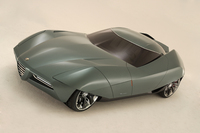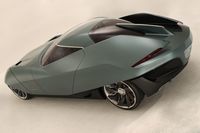Stile Bertone unveils the B.A.T. 11
GENEVA, SWITZERLAND - This project is the logical outcome of the evolution of the B.A.T. 5, B.A.T. 7 and B.A.T. 9, developed by Nuccio Bertone together with Alfa Romeo between 1953 and 1955. The aim at that time was to build aerodynamic cars: BAT stands for Berlinetta Aerodinamica Tecnica (Aerodynamic Technical Coupe).
These three models, designed by Franco Scaglione, had very advanced features for their time. They represent three important moments in automobile history and after many trials and tribulations found themselves the property of an avid collector in Las Vegas. They are now considered one of the most valuable collections in the world.
This new prototype has been designed with the Maserati GT chassis in mind, in order not to be a mere emotional copy of the past. It strives to be the BAT of the 3rd millennium, an authentic sportscar, in coherence with the history of the Bertone name. For example, its design was the most avant-garde among the various proposals, which is in line with
the designer’s penchant for strong messages. At the same time, creativity was combined with reality: the prototype scale model was fine tuned based on aerodynamic tests carried out at the Department Aeronautics and Space Engineering at the Polytechnic institute of Torino.
4,9 meters long, 1,9 meters wide, and 1,2 meters high, the design brings to the forefront some of the distinguishing elements of the BAT concept, such as the tapered fins and the faired wheels, all in a context where soft proportions are combined with strict and rough lines: a successful encounter of the typical Bertone themes that have inspired many. The fins seem to have been designed as a shawl that wraps around the car beginning from the front fender. In the rear there is suspended spoiler running lengthwise which uses a specific anchoring system. There is therefore a continuous flow of surfaces, volumes and open spaces that are uncovered piece by piece depending on the view angle.
Even the 21” faired wheels with Pirelli tires contribute to defining the model’s character: they are inspired by the spoked wheels of before and are fixed to the hub; they are made of alloy rims and carbon fiber segmented helical spokes that let one catch a glimpse of the Brembo brake calipers. It should also be noted that the body features that streamline the front wheels are mobile and provide for an electronic opening and closing system linked to the steering wheel to guarantee easy steering when parking. Seen from the front, the model clearly recalls Alfa Romeo: a long hood, very sleek in the upper part, which descends towards a sharp receding front bringing to mind the model designed by Bertone for the Alfa Montreal. At the center is the typical triangular shield with the circular brand logo on the top of the hood from which extend 3 horizontal lines that represent the Alfa Romeo “whiskers”: the central ones cut through the inlet which holds the LED lighting system supplied by OSRAM.
The side of the car is very simple, almost basic, and brings to the forefront two particularities that highlight the sporty nature of the car: the low widows combined with the high waistline and the cooling foils (which are also on the rear bumpers) optimize brake cooling. The doors were designed to open towards the front and slightly upwards, allowing access to a two seat cockpit designed to be simply and elegantly furnished, in line with the BAT concept. The dashboard is designed in wood, curved in the lower part on the driver’s side.
Finally, the grey-green color, linked to the Alfa Romeo brand and dear to Nuccio Bertone, is yet another element that contributes to carrying this particular style, created by a master, towards the future.




